If you are serious about woodworking, a table saw is a tool you will learn to rely on the most. Cross, rip, miter, bevel and compounds cuts are some of the things you can do with your table saw, and that’s just the tip of the iceberg. Furthermore, you can expand its functionality by adding various accessories to it. The possibilities are literally endless.
The first thing to understand is that unlike a standard saw, a table saw moves the material towards the blade which results in a much more precise cut. This is because things like fence and miter gauge assist you during all kinds of fabrication, and help you cut as straight or angled as you want.
Now, I’ve envisioned this article as a comprehensive guide which covers just about everything you need to know while still being concise enough to be read in a single breath. For those of you who want to know more, I’ve linked to other articles on my website that go into more detail about the subject.
For now, let’s take a look at some of the most important points to remember.
The Different Table Saw Types

Portable Jobsite Table Saw, One of the Most Popular Types
The first way to classify table saws is based on their portability. Portable models such as compact and jobsite table saws arrive mounted onto a stand that usually has transport wheels. This, along with the folding action allows for good portability. The stand is one of the things I am most impressed by on portable saws since they all have a unique and clever design.
Bench top saws do not come with a stand, but (as their name indicates) they rely on a table or a work bench for support. However, they are still considered portable because their small weight and dimension allows them to be picked up and carried from one location to another with relative ease.
Stationary saws include: Contractor, hybrid, and cabinet table saws. Contractor table saws are a source of confusion because the term is being used to refer to jobsite table saws as well which are the most rugged in construction, but still a far cry from true contractor saws. Hybrid table saws are similar in some aspects to contractor saws, but also feature some stuff found on full-size cabinet saws which is why most people often confuse the two. While they are similar on the surface it is a different story beneath the hood. Finally, cabinet saws are the largest, heaviest, most robust and powerful.
If you’re interested I have shed more light onto the matter in a separate article that deals solely with table saw types.
The Saw Blades
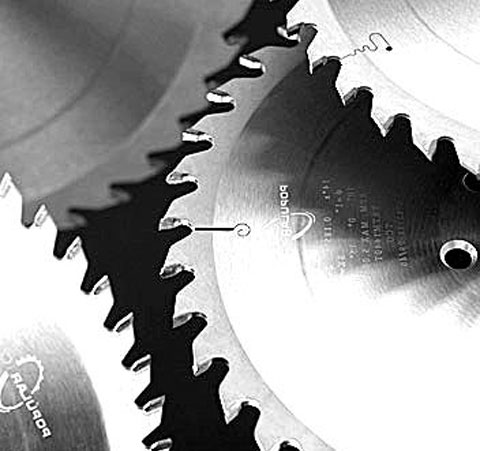 Table saw blades are usually divided based on their diameter, arbor size, number of teeth, kerf size, speed, application, as well as materials used in their construction. Most commercial table saws have either 10″ or 12″ blades while there are some models that feature blades as small as 5″, and as large as one foot.
Table saw blades are usually divided based on their diameter, arbor size, number of teeth, kerf size, speed, application, as well as materials used in their construction. Most commercial table saws have either 10″ or 12″ blades while there are some models that feature blades as small as 5″, and as large as one foot.
The number of teeth is usually between 24 and 80. Since most table saws nowadays are able to cut through other materials besides wood they often have blades which feature materials such as carbide, carbon, and (if you have the money) diamond-tipped teeth. This is a pretty extensive subject, so I would recommend you take a look at my article on blade essentials.
There is another dilemma that is often mentioned in the same breath as saw blades, and that’s: left vs. right tilt. The direction in which the blade tilts can provide you with some advantages as well as disadvantages, and my take on the whole subject is discussed in a separate article.
Fence and Miter Gauge
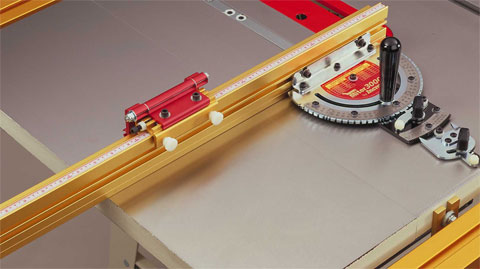 The fence is an essential part of any table saw. In fact, the fence is what gives it the advantage over other types of saw. The most common type found on table saws is a T-square fence which features robust design and good accuracy. Without it any kind of rip cut would be impossible.
The fence is an essential part of any table saw. In fact, the fence is what gives it the advantage over other types of saw. The most common type found on table saws is a T-square fence which features robust design and good accuracy. Without it any kind of rip cut would be impossible.
If you plan on making cross cuts or any kind of angled cut, you will need to rely on your saw’s miter gauge. I won’t get into how they work because it would take too much space here (and you might fall asleep reading it). However, you are welcome to read my guide on fences and miter gauges where I go into more detail about how they work, and how they should be used.
Motor
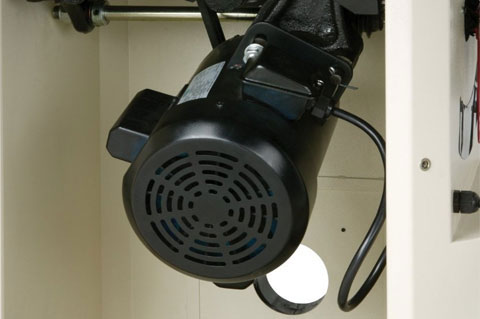 Table saws also differ from one another based on the type of motor they have. Smaller, portable table saws feature direct-drive motors that operate on 120V circuits, and are able to produce up to 2hp which is sufficient for cutting thinner material sheets.
Table saws also differ from one another based on the type of motor they have. Smaller, portable table saws feature direct-drive motors that operate on 120V circuits, and are able to produce up to 2hp which is sufficient for cutting thinner material sheets.
More powerful (and generally stationary) table saws feature motors that produce between 3 and 5hp, and rely on a belt drive to transfer the power from the motor to the blade. These operate on 240V. Reading specs expressed in volts, amps, and horsepower is a bit confusing, so I’ve prepared a short guide which explains how each of these determines the power of the saw.
Safety Features
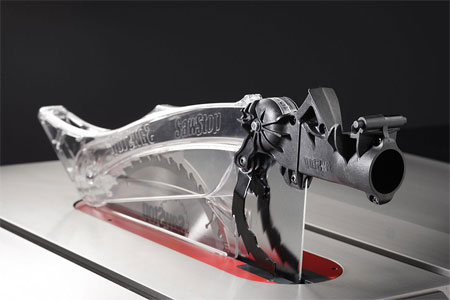
Needless to say, you do need some safety features on your table saw. When you have your hands inches away from a razor-sharp blade that spins at several thousand RPM you need to be careful. You should also be mindful of kickback which happens when wood binds between the back of the blade and the fence, or table.
Safety features such as splitters, riving knives, and anti-kickback pawls are there to minimize the chance of kickback while blade guards and advanced safety systems like the one found on SawStop’s table saws should help you keep all of your fingers intact! I have more on these features here.
Accessories
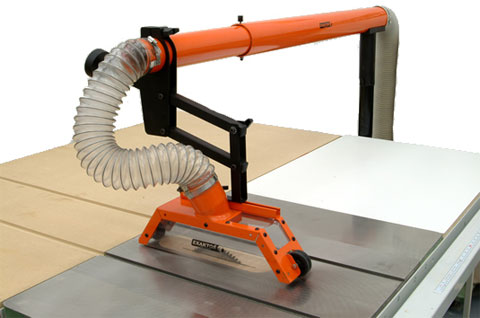 Table extensions, on/off switches, wheels that let you control the height and tilt of the blade, onboard storage, and dust collection systems (among others) can be found on nearly all table saws made by reputable brands. They can expand the basic functionality of the saw, making it easier to use like hand wheels, or safer such as on/off switches. You can also increase the rip capacity of the saw by attaching an extension table to it. More on these here.
Table extensions, on/off switches, wheels that let you control the height and tilt of the blade, onboard storage, and dust collection systems (among others) can be found on nearly all table saws made by reputable brands. They can expand the basic functionality of the saw, making it easier to use like hand wheels, or safer such as on/off switches. You can also increase the rip capacity of the saw by attaching an extension table to it. More on these here.
You can turn your table saw into the ultimate woodworking machine by providing it with a series of upgrades and accessories like better blade, or dado blade sets, a router table, cross cut sled, various jigs, molding heads, and so on. It’s hard to cover all of these since contractors usually make them on their own, and constantly come up with new options which increase the overall capability of table saws. The majority of these is covered in this article.
Summary
And there you have it, your ultimate guide to table saws! I’m not saying it is the best ever, but I have provided you with everything you need to know in a single article as well as links to other articles which expand on the subject.
It will save you hours, or even days of endless research. Trust me, table saws are so complex, and you will have a hard time putting all the pieces together on your own. I hope this guide will arm you with enough knowledge so you can at last choose the table saw that’s right for you and your workshop.
Good luck!
